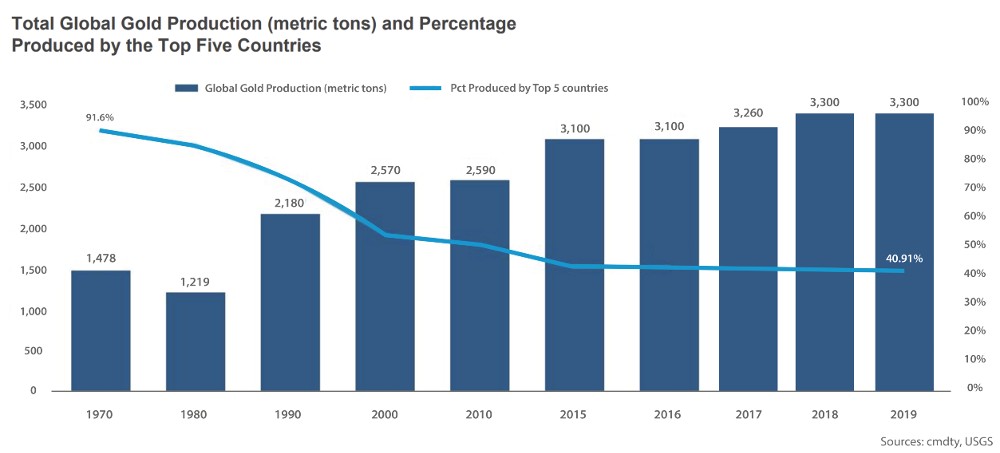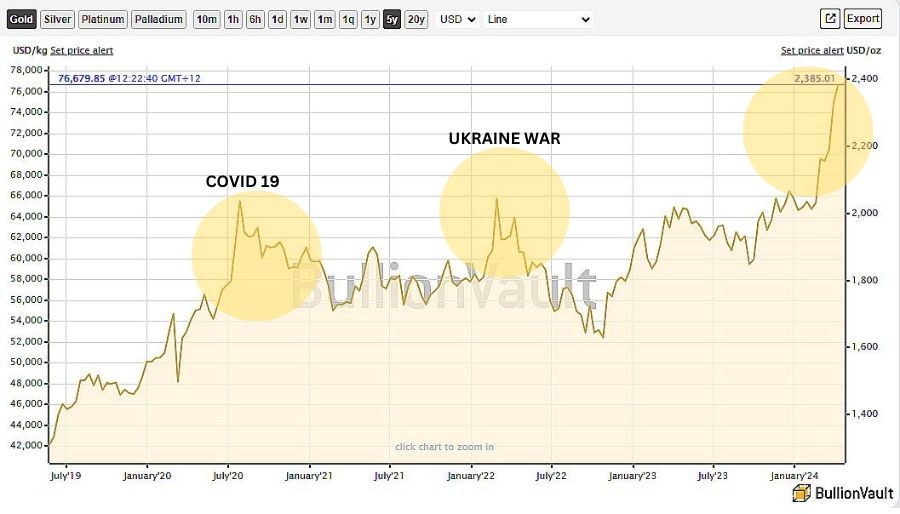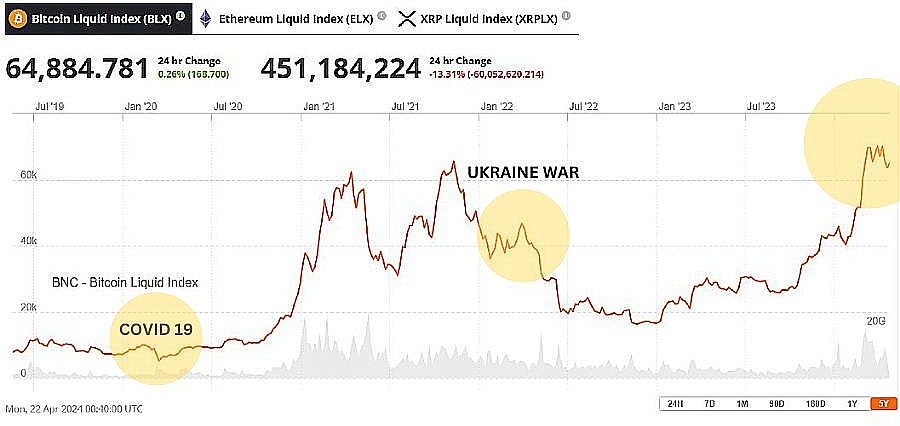With the 2024 Bitcoin halving completed, Bitcoin today has a lower inflation rate than gold. Could it finally become the ‘safe-haven’ it’s always promised to be?
Since the fourth Bitcoin halving was completed on April 19th 2024 analysts are pointing to a potentially significant shift in the cryptocurrency’s economic model. This shift now sees Bitcoin’s inflation rate—the rate at which new bitcoins are added to circulation—decline to levels lower than those of gold, traditionally the standard-bearer for low-inflation assets.
This development prompts a closer examination of what this means for Bitcoin, for gold, and for investors considering the future landscape of digital and traditional assets.
Understanding the Halving
Bitcoin’s halving is an event hardcoded into its blockchain protocol, occurring approximately every four years. It effectively reduces the reward that miners receive for verifying transactions and adding new blocks to the blockchain by 50%. The last halving, which occurred on April 19th 2024, decreased the Bitcoin reward for miners from 6.25 to 3.125 bitcoins per block. This mechanism controls the supply of bitcoins and mimics the scarcity dynamics of precious metals, thereby insulating the currency against inflation.
Bitcoin’s Inflation Rate Post The 2024 Halving
Prior to the successful halving on April 19th, each Bitcoin block took about 10 minutes to mine, and the Bitcoin network generated approximately 328,500 new Bitcoins annually. Post-halving, this number has now dropped to about 164,250 bitcoins a year. At the time of the halving, the total circulating supply of Bitcoin was close to 19.7 million—out of a maximum of 21 million. This sets the stage for a post-halving inflation rate of approximately 0.83% per annum.
Gold Vs Bitcoin: Inflation Rate Comparison
In contrast, gold, which has been a symbol of stability and a hedge against inflation for centuries, sees its total above-ground stock grow by about 1% to 1.5% each year, due to new mining output.

The production and addition of gold to the global market are influenced by a combination of factors including mining technology, geological availability, market demand, and various economic variables. Despite these fluctuations, the gold supply inflation rate has remained remarkably steady, reinforcing its role as a “safe haven” asset.
Today, Bitcoin’s inflation rate of 0.83% undercuts even the lower boundary of gold’s annual inflation rate. This marks a significant milestone for Bitcoin, potentially transitioning from a highly volatile investment to a more stable store of value—a quality long associated with gold.
Bitcoin – Finally The New Safe Haven?
This emerging dynamic prompts the question: could Bitcoin assume some of the safe haven characteristics traditionally held by gold? While Bitcoin’s journey has been marked by high volatility, its capped supply and decreasing inflation rate are features that align well with the criteria for a safe haven asset during times of economic uncertainty.
Certainly, the narrative that Bitcoin will behave as a safe haven asset like gold has been a topic of much debate within financial circles. To assess whether Bitcoin and gold are correlated, several factors and perspectives need to be considered:
Price Behavior and Correlation
- Volatility: Bitcoin is known for its high volatility compared to traditional safe haven assets like gold. This volatility stems from various factors including market sentiment, regulatory news, technological developments, and macroeconomic factors that do not typically affect gold prices in the same manner.
- Market Dynamics: The market dynamics of Bitcoin are considerably different from those of gold. Bitcoin’s market is relatively young, having been around since 2009, and it experiences large swings in price due to its nascent industry status and speculative interest. Gold, by contrast, has been a recognized store of value for millennia and is integrated into various sectors such as jewelry and electronics, in addition to its investment attributes.
- Reaction to Economic Stress: Gold has historically risen in times of economic uncertainty or inflation since it is considered a tangible asset with intrinsic value. Bitcoin, sometimes referred to as “digital gold,” has had instances where it has increased in value during times of market stress, but its reaction to such events is less consistent. For example, during the initial months of the COVID-19 pandemic, Bitcoin initially fell sharply in March 2020 before recovering and eventually starting a significant bull run, whereas gold displayed more consistent growth during the same period.
Statistical Correlation
- Empirical Data: Over the last five years, statistical analyses show that the correlation between Bitcoin and gold is generally weak. There are periods of slight positive correlation, particularly during times of heightened market stress, but these are not consistently maintained.
- Correlation Coefficient: The correlation coefficient between Bitcoin and gold fluctuates, typically ranging from slightly negative to mildly positive. This indicates that while both assets can sometimes react similarly to certain macroeconomic stimuli, their price movements are not strongly aligned.


Narrative vs. Reality
- Investor Perception: The perception of Bitcoin as a safe haven may be driven more by narrative and investor sentiment than by fundamental attributes. While some investors treat Bitcoin as a hedge against inflation and currency devaluation, similar to gold, this usage is not universally accepted or observed in market data. As the charts above show, funds did not flee to Bitcoin during Covid 19 or the start of the Ukraine war. It is also arguable that a Bitcoin all-time high that occurred in March 2024, had much more to do with the introduction of Bitcoin ETFs in the US, and the impending halving than it did a flight to safe-haven assets during times of high inflation.
- Market Maturity: Bitcoin’s market is evolving, and its role may also change over time. What it is today could be different in the next decade, potentially aligning more closely with traditional assets or carving out a unique niche.
Conclusion
Based on empirical data from the last five years, the narrative that Bitcoin should be correlated with gold as a safe haven asset does not hold consistently. While there are similarities in how both assets can be perceived as hedges against certain risks, their market behaviors and underlying fundamentals differ significantly. This makes Bitcoin a unique asset class, distinct from traditional safe havens like gold.
Nonetheless, with the 2024 Bitcoin halving now completed, the anticipated drop in Bitcoin’s inflation rate below that of gold represents a watershed moment for the cryptocurrency. While it is premature to predict whether Bitcoin will ever match gold in terms of market stability, the halving event will undoubtedly play a crucial role in Bitcoin’s maturation as an asset class. Investors and market watchers would do well to pay close attention to these developments, as they will not only influence the trajectory of Bitcoin but also potentially redefine what constitutes a safe haven in the digital age.
As the definition of “safe haven” assets evolves, so too do the instruments investors use to gain exposure to gold itself. From traditional Gold ETFs to emerging digital gold tokens like Pax Gold (PAXG) and Tether Gold (XAUT), there are now multiple ways to invest in gold—each with its own risk, cost, and regulatory profile. Explore how gold ETFs compare to digital gold and discover which may best suit your portfolio in this era of rapid financial innovation.







